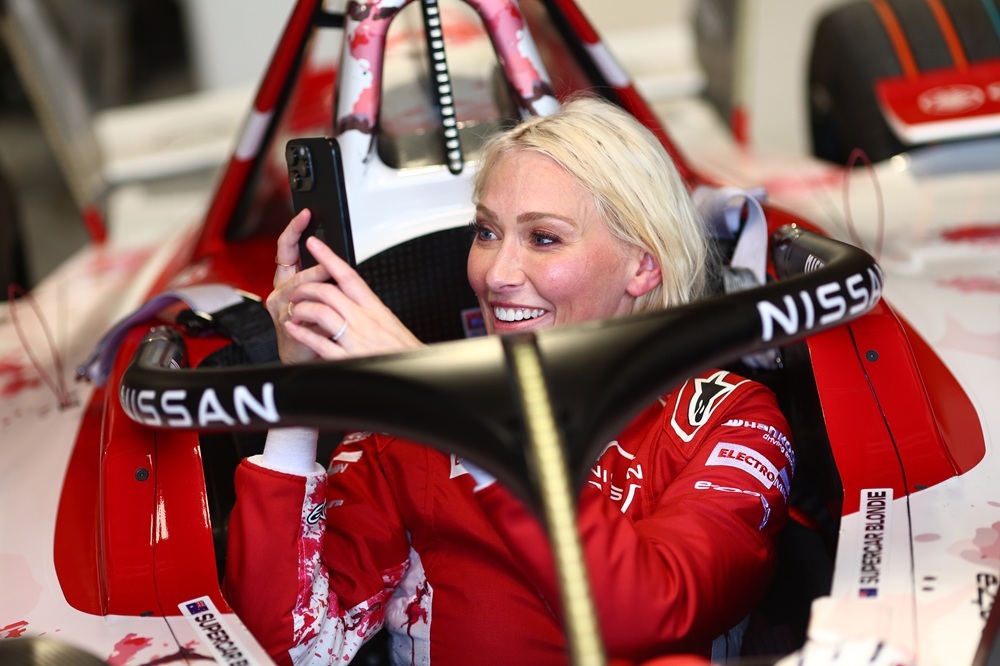
Formula E’s Evo Sessions track days in Miami gave a unique opportunity to get media personalities behind the wheel of the series’ GEN3 Evo racing cars so that they could experience what it’s like to be a professional racing driver – and take fans along for the ride, too. (That’s Alexandra Mary Hirschi, an Australian social media celebrity, presenter and vlogger known online as Supercar Blondie, pictured above in Nissan’s car ahead of her Evo Sessions run.)
But in the Lola Yamaha Abt garage, there was someone who fit in both camps. Scott Mansell has a well-established online presence, with his Driver61 YouTube channel having 1.34 million subscribers, but has also enjoyed a career as a professional driver across a plethora of series.
“I got a call from Formula E, and they said to me, ‘Would you like to come to Miami to drive a Formula E car?’ and I said, ‘Yes, absolutely!’” Mansell tells RACER of how his Evo Sessions opportunity came about. “Then they put me together with Lola Yamaha Abt, and all went from there.
“It’s a crazy idea, right? Putting some celebrities or creators in proper racing cars sounds absolutely crazy, and I think Formula E probably did a great job to convince the teams to actually do it in the first place. But then as we went through the couple of days, you could feel that it was a fantastic success.”
All involved didn’t just jump into the car and go. Each went through a lengthy preparation process with their assigned teams, but for Mansell, it was as if he was going racing once again.
“Every creator that I spoke to approached it in a very systematic and fairly careful way. I think it was a great success for all of the teams,” he says.
“I think some of the other drivers did have some racing or track experience, but obviously not as deep and as long as mine. I approached it like I was going racing, to be honest with you. I spent a couple of days in the simulator, I did as many laps as I could, I spoke to the engineers as much as I possibly could. I wanted to understand these cars as much as possible, and I had the same approach when I went to the racetrack.”
Despite having an outsider in their car for the first time, Mansell describes Lola Yamaha Abt as “an open book” at the event, and with his prior experience in a wide range of race cars, he was able to make the experience mutually beneficial.
“It was incredible, working with Zane Maloney, the driver, and all of the engineers — they shared everything with me,” he says. “And because I do have my experience, I was trying to give some proper feedback. Lola Yamaha’s a new team, they’re looking to develop the car, and so I was trying to help them as much as I possibly could.”
But while going into Evo Sessions as something of a racing veteran might seem like having a head start over the others, it actually meant that Mansell had to break some old habits – driving techniques that don’t quite work in an electric car.
“My main goal while I was there in the simulator was to understand primarily how to brake. The braking shape is very different to a traditional car,” he explains. “The first session, I didn’t do what I was doing in the simulator on the brakes. When you’re in a quick single seater, which the Formula E car is, my brain switched on to kind of like the F2 cars that I’ve driven in the past, and so I was getting on the brake with way too much pressure. And when you do that, because most of the braking is from the motors in the (Formula E) car, it triggered a fail.
“So in my first session, I had to come into the pits two or three times to reset the system because I kept on braking too hard — which wasn’t great from my side of things, because when you jump into a new car on a new track, you want to be doing consecutive laps so you can understand as much as possible about the car. So it was kind of truncated, a bit fragmented in that session. Then on the following day, I corrected all of the problems that I had and managed to pull a good lap together.”
At Evo Sessions, all 11 participants only got two 20-minute sessions on track. That doesn’t seem like a lot, given the hype around the event, and while Mansell tells me “I’d still be there now if I could be,” he admits that it was probably the perfect amount of time for the class of mostly non-racers.
“Of course, if you do more laps, you’re gonna go quicker, right?” he says. “I think it was probably the right amount of time, to be honest with you. In the past, I ran events like this where we would put non-drivers in racing cars, and there’s a sweet spot where they have enough time to start getting quickly but not get too confident. If you give them actually too much time, they’ll get overly confident, they get a bit too comfortable, and that’s when all the mistakes happen.
“We actually saw on the second day there that there were much more mistakes on the brakes and coming to the corners. We only had one spin on the first day, and then we saw three or four spins on the second day. So you give them another day, and actually those spins might be a bit bigger.”